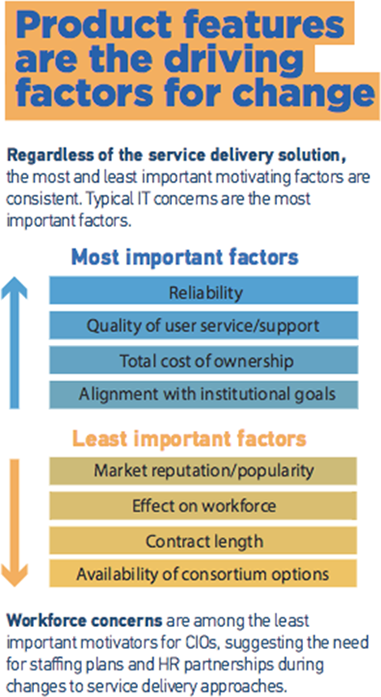The annual Top 10 IT Issues is the EDUCAUSE Review's most widely-read article. Publication of this article and its related resources would be difficult — if not impossible — without the work of the EDUCAUSE IT Issues Panel, whose quarterly conversations contribute to the top IT issues selection survey, article, and supplemental materials. This article is a summary of the panel's recent conversations regarding how to help users adapt to ongoing technology changes on their campuses.
Not only are higher education's technology possibilities evolving, but so is technology delivery. At their most recent meeting, EDUCAUSE IT Issues panelists discussed the changing IT services landscape. In-house hosted services are giving way to new service delivery models, such as cloud services, shared services, or outsourcing. The shift in technology delivery has been noted extensively in higher education and was the focus of a 2015 EDUCAUSE Center for Analysis and Research (ECAR) study, as well as the theme of the 2016 EDUCAUSE/NACUBO Enterprise IT Summit. For many panelists, moving service delivery externally is becoming more attractive in order to balance increased service demands with declining central IT resources. (See figure 1.)

Source: The Changing Face of IT Service Delivery Infographic
Figure 1. Institutional demand for external services
Another driver emerged during the panel's conversation — market dynamics. Current vendors might have fallen behind on system upgrades; new players like Workday and Oracle offer new alternatives. More applications and systems simply aren't available in "traditional" in-house hosted solutions, forcing delivery change. So IT leaders turn to new ways to deliver services.

Source: The Changing Face of IT Service Delivery Infographic
Figure 2. Factors driving service change
With new services comes the need for change management, especially to support users. But service planning doesn't always fully recognize the "people" dimensions; ECAR research shows that the effect on workforce is one of the least important motivating factors (see figure 2). Panelists observed that new service delivery often involves new business process redesign, and it can be hard for users to let go of familiar, entrenched ways of completing tasks. They described the perils of change fatigue: users who push back from adapting to a constant stream of new or updated services, saying, "Enough is enough."
During their conversation, IT Issues panelists concluded that user change management must be an integral part of any institutional service delivery change. Without successfully managing the user experience, campus technology improvements and advancements may fail to meet the institution's business and academic needs. Panelists and ECAR research (see the resource list below) outlined several user change management strategies:
- Understand the risks: At the very least, IT leaders should fully understand the potential value, challenges, resource requirements, and cultural disruption that will occur when moving from legacy to new system and data architectures, processes, methodologies, and service delivery.1
- Build user partnerships: Create buy-in by illustrating to stakeholders all the currently existing variations of the same process, with the goal of working together to create one or two efficient processes. Don't skimp on communication about upcoming technology changes with users — especially with faculty — who might not be as technologically agile as students. Other panelists pointed to the use of faculty evangelists to educate and mentor the general faculty community on technology change, or to encourage the faculty to participate in pilots to test new systems, getting them involved earlier in the implementation process.
- Prepare the IT organization: Make IT staff partners in change, too. Ensure they feel engaged, emboldened, and capable to support system changes. Make workforce engagement the responsibility of supervisors and leaders and not the "problem" of the workforce itself.2 Formal actions can help, too. For example, a change management program can help staff understand how changes to the service delivery model will impact them.3 New IT positions — e.g., IT service management specialists, change management specialists, vendor managers, and ITIL specialists4 — can provide focused management.
- Communicate progress: Keep the institution engaged in change by reporting success and progress in system changes. Demonstrated progress can increase resolve to stay the course with infrastructure and process changes.5
Ensuring the success of user change management in today's higher education service delivery landscape is crucial. There are a number of resources available to institutions considering such issues:
- Nathan Culmer, "Leading Change in Higher Education," EDUCAUSE Review, December 7, 2015.
- Linda Hartford, "A Matter of Change," EDUCAUSE Review, February 26, 2016.
- Sharon Hayward and Scott Siler, "Hooray for Change! Building Buzz, Buy-In, and Adoption Using Change Management," Presentation, EDUCAUSE Annual Conference 2015, October 28, 2015.
- Marc Holt, "Change Management and Cultural Resistance," EDUCAUSE Review, April 25, 2015.
- The IT Service Organization for a Post-Enterprise World
Notes
- Susan Grajek, Trend Watch 2016: Which IT Trends Is Higher Education Responding To? research report (Louisville, CO: ECAR, March 7, 2016), 33.
- Ibid., 33.
- D. Christopher Brooks, The Changing Face of IT Service Delivery in Higher Education, research report (Louisville, CO: ECAR, August 2015), 19.
- Jacqueline Bichsel, IT Service Delivery in Higher Education: Current Methods and Future Directions, research report (Louisville, CO: ECAR, April 2015), 10.
- Grajek, 33.
Judith A. Pirani is a consultant at the EDUCAUSE Center for Analysis and Research (ECAR) and president of Sheep Pond Associates.
© 2016 Judith A. Pirani. This EDUCAUSE Review blog is licensed under the Creative Commons BY-NC-SA 4.0 International license.
